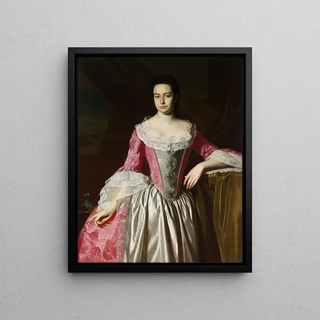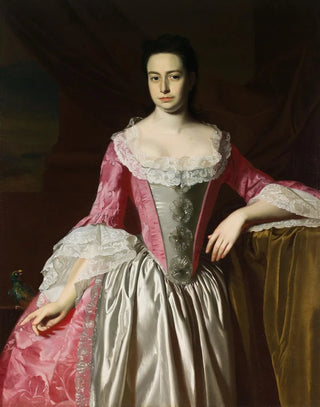Art print | Eunice Dennie Burr - John Singleton Copley


View from behind

Frame (optional)
Reproduction of Eunice Dennie Burr by John Singleton Copley – Captivating Introduction
The "Eunice Dennie Burr" art print by John Singleton Copley, an iconic 18th-century masterpiece, embodies the very essence of American portraiture at a time when art served to immortalize figures of society. This depiction of a high-society woman, both elegant and introspective, immerses us in a universe where refinement and psychology intersect. Copley, through his skill in capturing subtle nuances of light and intricate textures, offers a fascinating glimpse into the life and values of his era. The art print of this work allows us to rediscover not only the artist's technique but also the social and cultural context in which it was created.
Style and uniqueness of the work
The piece stands out for its meticulous attention to detail and the psychological depth emanating from the subject's face. Copley, a master of light, skillfully plays with shadows and reflections, creating an atmosphere that is both intimate and solemn. The carefully harmonized colors evoke a palette that is rich yet delicate, enhancing Eunice Dennie Burr's natural beauty. The background, often shaded, highlights the main subject, making her the focal point of the composition. This ability to guide the viewer’s gaze while allowing immersion into the surrounding details demonstrates Copley's genius. Through this work, one perceives not only the aesthetic of the period but also a sensitivity that transcends time.
The artist and his influence
John Singleton Copley, born in Boston, was a painter whose work marked the transition from colonial art to modern American art. Influenced by great European masters, he developed a unique style that combines realism and idealization. Copley did not merely reproduce faces; he sought to capture the soul of his subjects. His technique, blending precision and expressiveness, paved the way for many American artists, and his impact is still felt today. As a pioneer of American portraiture, he succeeded in establishing an artistic identity that reflects

Matte finish

View from behind

Frame (optional)
Reproduction of Eunice Dennie Burr by John Singleton Copley – Captivating Introduction
The "Eunice Dennie Burr" art print by John Singleton Copley, an iconic 18th-century masterpiece, embodies the very essence of American portraiture at a time when art served to immortalize figures of society. This depiction of a high-society woman, both elegant and introspective, immerses us in a universe where refinement and psychology intersect. Copley, through his skill in capturing subtle nuances of light and intricate textures, offers a fascinating glimpse into the life and values of his era. The art print of this work allows us to rediscover not only the artist's technique but also the social and cultural context in which it was created.
Style and uniqueness of the work
The piece stands out for its meticulous attention to detail and the psychological depth emanating from the subject's face. Copley, a master of light, skillfully plays with shadows and reflections, creating an atmosphere that is both intimate and solemn. The carefully harmonized colors evoke a palette that is rich yet delicate, enhancing Eunice Dennie Burr's natural beauty. The background, often shaded, highlights the main subject, making her the focal point of the composition. This ability to guide the viewer’s gaze while allowing immersion into the surrounding details demonstrates Copley's genius. Through this work, one perceives not only the aesthetic of the period but also a sensitivity that transcends time.
The artist and his influence
John Singleton Copley, born in Boston, was a painter whose work marked the transition from colonial art to modern American art. Influenced by great European masters, he developed a unique style that combines realism and idealization. Copley did not merely reproduce faces; he sought to capture the soul of his subjects. His technique, blending precision and expressiveness, paved the way for many American artists, and his impact is still felt today. As a pioneer of American portraiture, he succeeded in establishing an artistic identity that reflects






